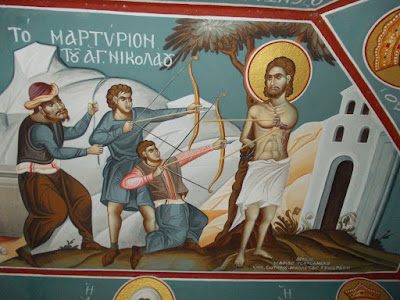
When the Avars invaded Thessaly, they caused much devestation and death. Nicholas with his armed forces tried to halt the enemy. However, because the Avars were in such great numbers, they succeeded to invade the land and conducted many massacres and much looting. Several of the residents fled to the city or the mountains. Nicholas and his soldiers retreated to the village called Vounena, where there existed several hermitages in the steep hills. He settled there with his soldiers, and they assumed a life of chastity and prayer. He and his soldiers lived the angelic life of monasticism.
One evening, while in prayer, the Angel of the Lord appeared and announced to Nicholas that his disciples would soon be martyred for Christ. Indeed, the enemies captured them, and submitted them to a multitude of torments. They urged them to abandon the faith and worship the Avar "gods," as well as swear their allegiance to the Avar chief. But they remained faithful to Christ and their names have thus been written in the Book of Life. The holy martyrs are known to be the monks Gregory, Demetrius, Evodius, Theodore, John, Michael, Pancratius, Panteleon, Christopher and Emilian, and the nuns Irene and Pelagia.
Nicholas has himself escaped and continued his ascetic life, lodging in a cave which was covered by an oak tree. But soon he too was also captured and martyred for Christ. The barbarian invaders captured him and tortured him, attempting to convince him to deny the Faith. But he bravely resisted. He was tortured for ten days, until he received the crown of glory and entered into the choir of martyrs.
The Bishop of Larisa transferred his relics to the city of Tyrnabus. Years later, the Euphemian, the Duke of Thessalonica, discovered the relics. Euphemian suffered from the illness of leprosy. He searched for the treatments of doctors, but in vain. However, when he was visiting Larisa, he was advised to go to the place called Vounena for the feastday of St. Nicholas the New, and to witness the miracle of the blood that comes out of his cave of dwelling, out of the oak tree, and out of his grave, each year on his feastday.
Duke Euphemian went to Vounena, and anointed his body with the miraculously-appearing red liquid. He was immediately healed from leprosy, and glorified God who worked wonders through this holy saint. To thank the saint, he built a chapel dedicated to St. Nicholas, and placed the holy relics of St. Nicholas therein." The Holy Skull of St. Nicholas the New of Vounena is also treasured at the Monastery of St. Nicholas on Andros. (taken from: http://www.genuineorthodoxchurch.net/miraclevounena.html)
For another account of the Saint, see: http://www.agiosnikolaosneos.gr/index.php?option=com_content&view=article&id=4&Itemid=4.
May St. Nicholas the New intercede for all of us and help us!
 Icon of St. Nicholas the New Osiomartyr of Vounena (Icon courtesy of www.eikonografos.com used with permission)
Icon of St. Nicholas the New Osiomartyr of Vounena (Icon courtesy of www.eikonografos.com used with permission) Apolytikion of St. Nicholas the New - 4th Tone (amateur translation)
Apolytikion of St. Nicholas the New - 4th Tone (amateur translation)












No comments:
Post a Comment